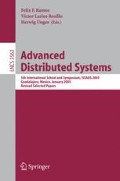Abstract
Our research is interested in behavioral animation among virtual reality applications. A major concern in this field is animating background actors and modeling their interactions. The aim is to provide virtual agents behaviors enabling them to evolve an autonomous and coordinated way in dynamic environments.
The behavior is modeled through the standard perception/decision/action loop where the characteristics of the decision module determine the agent abilities. The artificial intelligence “cognitive” agents have reasoning capabilities upon symbolic representations of the objects surrounding them, the way humans do. The artificial life agents possess the reactive and adaptive features from life imitation techniques.
The canvas of behavioral animation combine both approaches in order to obtain autonomous, coherent, reactive and adaptive agents. The so-called “hybrid” agents are for the most cognitive agents including reactive features. Two properties follow: they handle symbolic information and they store it in a memory regarded as a passive module.
We propose a different approach, focused on memory. We consider memory as an active component of cognition and reasoning or intelligence as the emergent expression of its operating. While keeping an “artificial life” view, we propose an original hybrid architecture which avoids the traditional reactiveness/cognition dichotomy and relies on distributed implicit mental representations.
Our model is a neural networks based architecture where two dimensions are considered: Whereas a vertical dimension models the procedural perception/action associations which form the reactiveness of a behavior, a horizontal dimension introduces the semantic concept association.
Access this chapter
Tax calculation will be finalised at checkout
Purchases are for personal use only
Preview
Unable to display preview. Download preview PDF.
References
Atkinson, R.C., Shiffrin, R.M.: Human memory: A proposed system and its control processes. In: Spence, K.W. (ed.) The Psychology of Learning and Motivation: advances in research and theory. 2, Academic Press, New-York (1968)
Brooks, R.A.: A robust layered control system for a mobile robot. IEEE Journal of Robotics and Automation, 14–23 (1986)
Bryson, J.: Cross-paradigm analysis of autonomous agent architecture. Journal of Experimental and Theoretical Artificial Intelligence (JETAI) 12(2), 165–189 (2000)
Clancey, W.J.: Situated Cognition: On human knowledge and Computer Representations. Cambridge University Press, Cambridge (1997)
Cohen, N.J., Squire, L.R.: Preserved learning and retention of pattern analyzing skill in amnesia: Dissociation of knowing how and knowing that. Science 210, 207–209 (1980)
Collins, A.M., Ross Quillian, M.: Retrieval time from semantic memory. Journal of Verbal Learning and Verbal Behavior 8, 240–248 (1969)
Collins, A.M., Loftus, E.: A spreading activation theory of semantic memory. Psychological Review 82, 407–428 (1975)
Craik, F.I.M., Lockhart, R.S.: Levels of processing: A framework for memory research. Journal of Verbal Learning and Verbal Behavior 11, 671–684 (1972)
S. Donikian. Modélisation, contrôle et animation d’agents virtuels autonomes évoluant dans des environnements informés et structurés. Habilitation à diriger les recherches, août (2004)
Donikian, S., Rutten, E.: Reactivity, concurrency, data-flow and hierarchical preemption for behavioral animation. In: Fifth Eurographics Workshop on Programming Paradigms in Graphics, springer, Heidelberg (1995)
Fahlman, S.E.: NETL: a system for representing and using real world knowledge. MIT Press, Cambridge (1979)
Ferguson, I.A.: Touringmachines: Autonomous agents with attitudes. IEEE Computer 25(5), 51–55 (1992)
Gluck, M.A., Myers, C.E.: Gateway To Memory, November 2000. MIT Press, Cambridge (2000)
Hebb, D.: The Organisation Of Behavior. Wiley, Chichester (1949)
Kohonen, T.: Self-organized formation of topologically correct feature maps. Biological Cybernetics 43, 59–69 (1982)
Lamarche, F.: Humanoídes virtuels, réaction et cognition: une architecture pour leur autonomie. PhD thesis, Université de Rennes I, Décembre (2003)
Lashley, K.S.: Brain mechanism and intelligence: A quantitative study of injuries to the brain. Chicago University Press, Chicago (1929)
McCulloch, W.S., Pitts, W.: A logical calculus of the ideas immanent in nervous activity. Bulletin of mathematical biophysics 5, 115–133 (1943)
Minsky, M., Papert, S.: Perceptrons: an Introduction to Computational Geometry. MIT Press, Cambridge (1968)
Rescorla, R., Wagner, A.R.: A theory of pavlovian conditionning: Variations in the effectiveness of reinforcement and non-reinforcement. In: Black, A., Prokasy, W. (eds.) Classical Conditionning II: Current Research and Theory, pp. 64–99. Appleton-Century-Crofts, New-York (1972)
Rosenblatt, F.: The perceptron: probabilistic model for information storage and organisation in the brain. Psychological Review 65, 386–408 (1958)
Rumelhart, D.E., Hinton, G.E., Williams, R.J.: Learning internal representations by error propagation. In: Rumelhart, D., McClelland, J. (eds.) Parallel Distributed Processing: Exploration in the microstructure of cognition, pp. 318–362. MIT Press, Cambrigde (1986)
Rumelhart, D.E., McClelland, J.L.: Parallel Distributed Processing: Explorations in the Microstructure of Cognition, vol. 1(2). MIT Press, Cambridge (1986)
Sowa, J.F.: Conceptual structures. In: Information Processing in Mind and Machine, Addison Wesley, Reading (1984)
Widrow, B., Hoff, M.E.: Adaptative switching circuits. Institute of Radio Engineers, Western Electronic Show and Convention Record 4, 96–104 (1960)
Author information
Authors and Affiliations
Editor information
Editors and Affiliations
Rights and permissions
Copyright information
© 2005 Springer-Verlag Berlin Heidelberg
About this paper
Cite this paper
Panzoli, D., Luga, H., Duthen, Y. (2005). Memory as an Active Component of a Behavioral Animation System. In: Ramos, F.F., Larios Rosillo, V., Unger, H. (eds) Advanced Distributed Systems. ISSADS 2005. Lecture Notes in Computer Science, vol 3563. Springer, Berlin, Heidelberg. https://doi.org/10.1007/11533962_41
Download citation
DOI: https://doi.org/10.1007/11533962_41
Publisher Name: Springer, Berlin, Heidelberg
Print ISBN: 978-3-540-28063-7
Online ISBN: 978-3-540-31674-9
eBook Packages: Computer ScienceComputer Science (R0)

